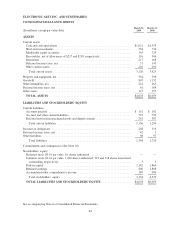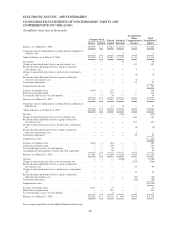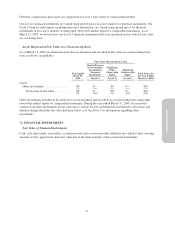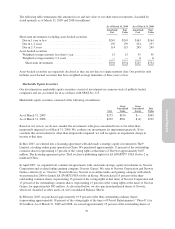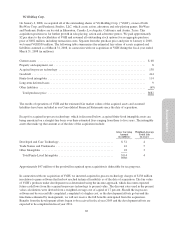Electronic Arts 2009 Annual Report Download - page 154
Download and view the complete annual report
Please find page 154 of the 2009 Electronic Arts annual report below. You can navigate through the pages in the report by either clicking on the pages listed below, or by using the keyword search tool below to find specific information within the annual report.Employee stock-based compensation expense is calculated based on awards ultimately expected to vest and is
reduced for estimated forfeitures. Forfeitures are revised, if necessary, in subsequent periods if actual forfeitures
differ from those estimates and an adjustment is recognized at that time.
Changes to our underlying stock price, our assumptions used in the Black-Scholes option valuation calculation
and our forfeiture rate, as well as future equity granted or assumed through acquisitions could significantly
impact compensation expense to be recognized in fiscal year 2010 and future periods.
Acquired In-Process Technology
The value assigned to acquired in-process technology is determined by identifying those acquired specific
in-process research and development projects that would be continued and for which (1) technological feasibility
had not been established as of the acquisition date, (2) there is no alternative future use, and (3) the fair value is
able to be estimated with reasonable reliability.
Foreign Currency Translation
For each of our foreign operating subsidiaries, the functional currency is generally its local currency. Assets and
liabilities of foreign operations are translated into U.S. dollars using month-end exchange rates, and revenue and
expenses are translated into U.S. dollars using average exchange rates. The effects of foreign currency translation
adjustments are included as a component of accumulated other comprehensive income in stockholders’ equity.
Foreign currency transaction gains and losses are a result of the effect of exchange rate changes on transactions
denominated in currencies other than the functional currency. Net foreign currency transaction gains (losses) of
$(49) million, $20 million and $10 million for the fiscal years ended March 31, 2009, 2008 and 2007,
respectively, are included in interest and other income, net, in our Consolidated Statements of Operations.
Impact of Recently Issued Accounting Standards
In December 2007, the Financial Accounting Standards Board (“FASB”) issued SFAS No. 141 (Revised 2007)
(“SFAS No. 141(R)”), Business Combinations, which requires the recognition of assets acquired, liabilities
assumed, and any noncontrolling interest in an acquiree at the acquisition date fair value with limited exceptions.
SFAS No. 141(R) will change the accounting treatment for certain specific items and includes a substantial
number of new disclosure requirements. In April 2009, the FASB issued Staff Position (“FSP”) Financial
Accounting Standard (“FAS”) 141(R)-1, Accounting for Assets Acquired and Liabilities Assumed in a Business
Combination That Arise from Contingencies. FSP FAS 141(R)-1 amends and clarifies SFAS No. 141(R) to
amend the initial recognition and measurement, subsequent measurement and accounting, and disclosure of
assets and liabilities arising from contingencies in a business combination. SFAS No. 141(R) and FSP FAS
141(R)-1 apply prospectively to business combinations for which the acquisition date is on or after the beginning
of the first annual reporting period beginning on or after December 15, 2008. We are currently evaluating the
impact FSP FAS 141(R)-1 will have on our Consolidated Financial Statements. The adoption of SFAS
No. 141(R) will have a material impact on our Consolidated Financial Statements for material acquisitions
consummated on or after March 29, 2009.
In December 2007, the FASB issued SFAS No. 160, Noncontrolling Interests in Consolidated Financial
Statements — an amendment of ARB No. 51, which establishes new accounting and reporting standards for
noncontrolling interests (e.g., minority interests) and for the deconsolidation of a subsidiary. SFAS No. 160 also
includes expanded disclosure requirements regarding the interests of the parent and its noncontrolling interests.
SFAS No. 160 is effective for fiscal years, and interim periods within those fiscal years, beginning on or after
December 15, 2008. We do not expect the adoption of SFAS No. 160 to have a material impact on our
Consolidated Financial Statements.
In December 2007, the FASB ratified EITF’s consensus conclusion on EITF 07-01, Accounting for Collaborative
Arrangements. EITF 07-01 defines collaborative arrangements and establishes reporting requirements for
74


